Qinghai Lake greets migration peak of naked carp
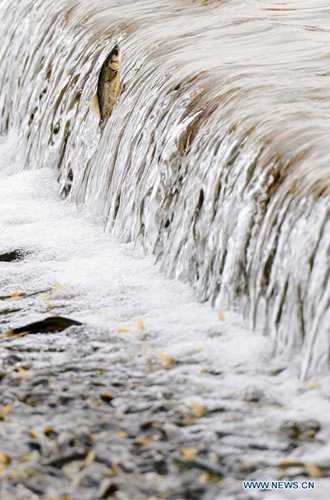
A naked carp swims upstream in Shaliu River, Gangca County of northwest China's Qinghai Province, July 6, 2019. The species of carp, known in China as huangyu, is endemic to the Qinghai Lake, China's largest inland saltwater lake located on the plateau. From late May to mid-August every year, the carp swim upstream to freshwater rivers to spawn, with the migration peaking in late June. The fish was listed on the China Species Red List in 2004 due to overfishing and habitat loss. Thanks to the increased efforts of volunteers and intensified law enforcement, the stock of the carp in the lake has largely climbed in recent years. (Photo: Xinhua)
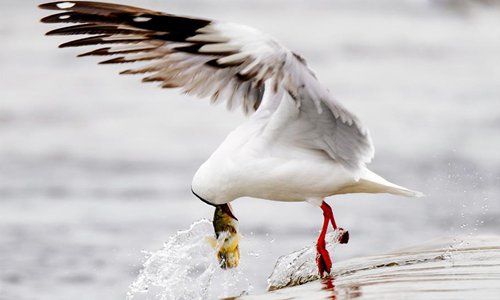
A brown-headed gull catches a naked carp in Shaliu River, Gangca County of northwest China's Qinghai Province, July 6, 2019. The species of carp, known in China as huangyu, is endemic to the Qinghai Lake, China's largest inland saltwater lake located on the plateau. From late May to mid-August every year, the carp swim upstream to freshwater rivers to spawn, with the migration peaking in late June. The fish was listed on the China Species Red List in 2004 due to overfishing and habitat loss. Thanks to the increased efforts of volunteers and intensified law enforcement, the stock of the carp in the lake has largely climbed in recent years.(Photo: Xinhua)
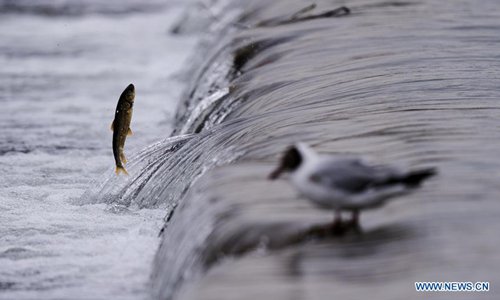
A naked carp swims upstream in Shaliu River, Gangca County of northwest China's Qinghai Province, July 6, 2019. The species of carp, known in China as huangyu, is endemic to the Qinghai Lake, China's largest inland saltwater lake located on the plateau. From late May to mid-August every year, the carp swim upstream to freshwater rivers to spawn, with the migration peaking in late June. The fish was listed on the China Species Red List in 2004 due to overfishing and habitat loss. Thanks to the increased efforts of volunteers and intensified law enforcement, the stock of the carp in the lake has largely climbed in recent years. (Photo: Xinhua)
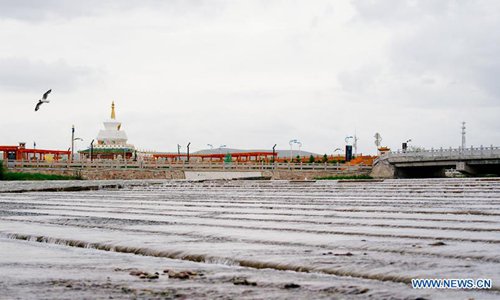
Brown-headed gulls fly over the Shaliu River, Gangca County of northwest China's Qinghai Province, July 6, 2019. The species of carp, known in China as huangyu, is endemic to the Qinghai Lake, China's largest inland saltwater lake located on the plateau. From late May to mid-August every year, the carp swim upstream to freshwater rivers to spawn, with the migration peaking in late June. The fish was listed on the China Species Red List in 2004 due to overfishing and habitat loss. Thanks to the increased efforts of volunteers and intensified law enforcement, the stock of the carp in the lake has largely climbed in recent years. (Photo: Xinhua)
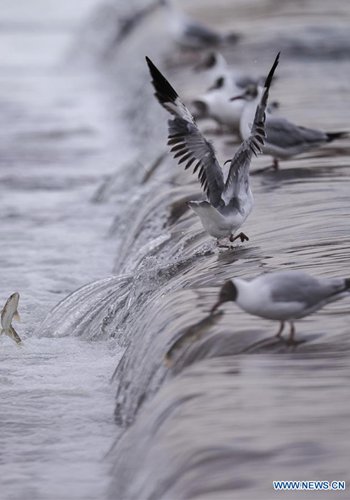
Brown-headed gulls catch naked carps in Shaliu River, Gangca County of northwest China's Qinghai Province, July 6, 2019. The species of carp, known in China as huangyu, is endemic to the Qinghai Lake, China's largest inland saltwater lake located on the plateau. From late May to mid-August every year, the carp swim upstream to freshwater rivers to spawn, with the migration peaking in late June. The fish was listed on the China Species Red List in 2004 due to overfishing and habitat loss. Thanks to the increased efforts of volunteers and intensified law enforcement, the stock of the carp in the lake has largely climbed in recent years.(Photo: Xinhua)
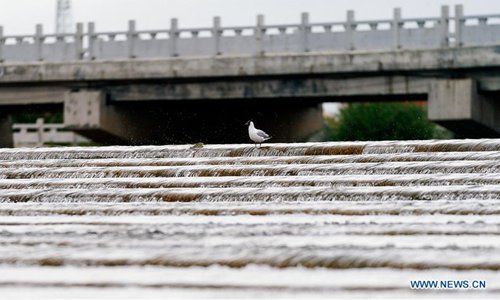
A naked carp swims upstream in Shaliu River, Gangca County of northwest China's Qinghai Province, July 6, 2019. The species of carp, known in China as huangyu, is endemic to the Qinghai Lake, China's largest inland saltwater lake located on the plateau. From late May to mid-August every year, the carp swim upstream to freshwater rivers to spawn, with the migration peaking in late June. The fish was listed on the China Species Red List in 2004 due to overfishing and habitat loss. Thanks to the increased efforts of volunteers and intensified law enforcement, the stock of the carp in the lake has largely climbed in recent years. (Photo: Xinhua)
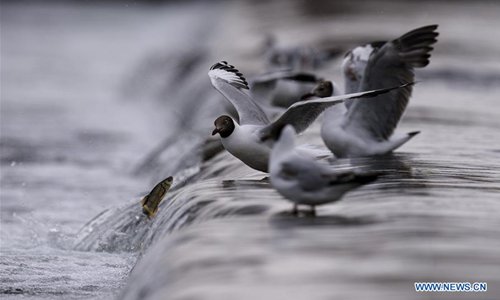
Brown-headed gulls wait for catching naked carp in Shaliu River, Gangca County of northwest China's Qinghai Province, July 6, 2019. The species of carp, known in China as huangyu, is endemic to the Qinghai Lake, China's largest inland saltwater lake located on the plateau. From late May to mid-August every year, the carp swim upstream to freshwater rivers to spawn, with the migration peaking in late June. The fish was listed on the China Species Red List in 2004 due to overfishing and habitat loss. Thanks to the increased efforts of volunteers and intensified law enforcement, the stock of the carp in the lake has largely climbed in recent years. (Photo: Xinhua)
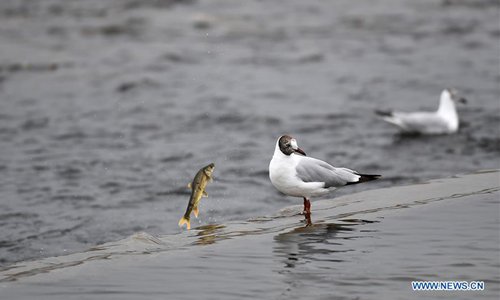
A brown-headed gull waits for catching naked carp in Shaliu River, Gangca County of northwest China's Qinghai Province, July 6, 2019. The species of carp, known in China as huangyu, is endemic to the Qinghai Lake, China's largest inland saltwater lake located on the plateau. From late May to mid-August every year, the carp swim upstream to freshwater rivers to spawn, with the migration peaking in late June. The fish was listed on the China Species Red List in 2004 due to overfishing and habitat loss. Thanks to the increased efforts of volunteers and intensified law enforcement, the stock of the carp in the lake has largely climbed in recent years.(Photo: Xinhua)
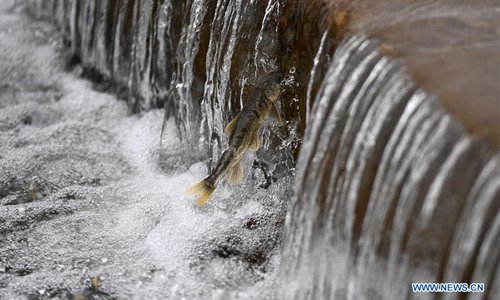
A naked carp swims upstream in Shaliu River, Gangca County of northwest China's Qinghai Province, July 6, 2019. The species of carp, known in China as huangyu, is endemic to the Qinghai Lake, China's largest inland saltwater lake located on the plateau. From late May to mid-August every year, the carp swim upstream to freshwater rivers to spawn, with the migration peaking in late June. The fish was listed on the China Species Red List in 2004 due to overfishing and habitat loss. Thanks to the increased efforts of volunteers and intensified law enforcement, the stock of the carp in the lake has largely climbed in recent years.(Photo: Xinhua)
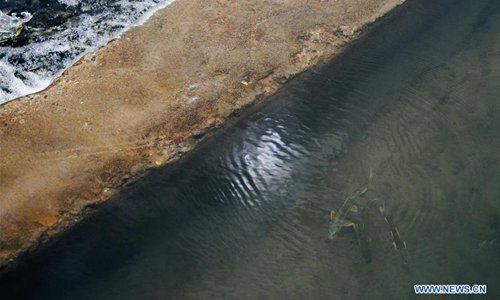
Naked carp swim in Shaliu River, Gangca County of northwest China's Qinghai Province, July 6, 2019. The species of carp, known in China as huangyu, is endemic to the Qinghai Lake, China's largest inland saltwater lake located on the plateau. From late May to mid-August every year, the carp swim upstream to freshwater rivers to spawn, with the migration peaking in late June. The fish was listed on the China Species Red List in 2004 due to overfishing and habitat loss. Thanks to the increased efforts of volunteers and intensified law enforcement, the stock of the carp in the lake has largely climbed in recent years. (Photo: Xinhua)
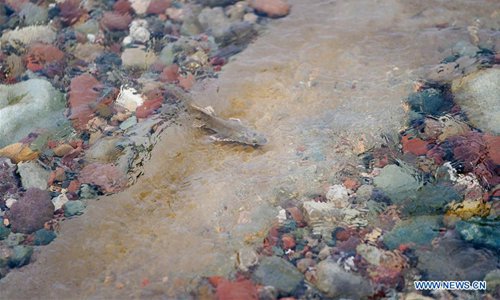
A naked carp swims upstream in Shaliu River, Gangca County of northwest China's Qinghai Province, July 6, 2019. The species of carp, known in China as huangyu, is endemic to the Qinghai Lake, China's largest inland saltwater lake located on the plateau. From late May to mid-August every year, the carp swim upstream to freshwater rivers to spawn, with the migration peaking in late June. The fish was listed on the China Species Red List in 2004 due to overfishing and habitat loss. Thanks to the increased efforts of volunteers and intensified law enforcement, the stock of the carp in the lake has largely climbed in recent years. (Photo: Xinhua)
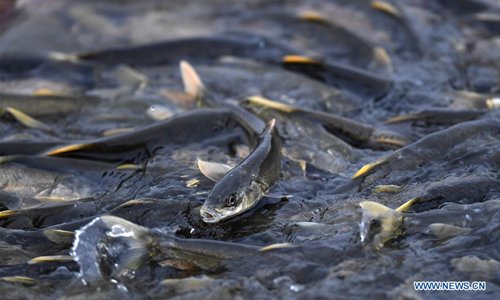
Naked carp swim upstream in Shaliu River, Gangca County of northwest China's Qinghai Province, July 6, 2019. The species of carp, known in China as huangyu, is endemic to the Qinghai Lake, China's largest inland saltwater lake located on the plateau. From late May to mid-August every year, the carp swim upstream to freshwater rivers to spawn, with the migration peaking in late June. The fish was listed on the China Species Red List in 2004 due to overfishing and habitat loss. Thanks to the increased efforts of volunteers and intensified law enforcement, the stock of the carp in the lake has largely climbed in recent years. (Photo: Xinhua)
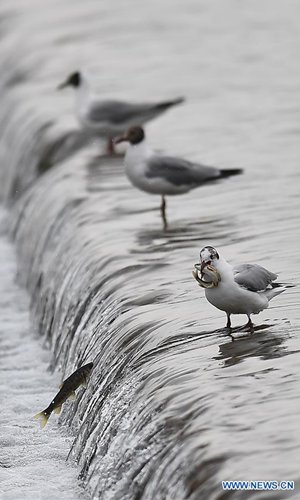
Brown-headed gulls catch naked carps in Shaliu River, Gangca County of northwest China's Qinghai Province, July 6, 2019. The species of carp, known in China as huangyu, is endemic to the Qinghai Lake, China's largest inland saltwater lake located on the plateau. From late May to mid-August every year, the carp swim upstream to freshwater rivers to spawn, with the migration peaking in late June. The fish was listed on the China Species Red List in 2004 due to overfishing and habitat loss. Thanks to the increased efforts of volunteers and intensified law enforcement, the stock of the carp in the lake has largely climbed in recent years.(Photo: Xinhua)
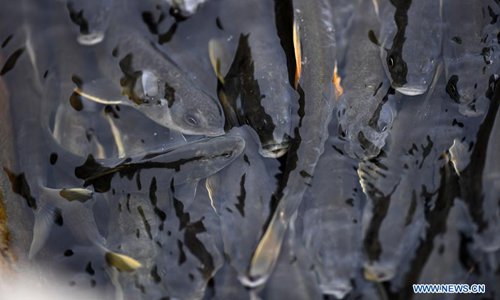
Naked carps swim upstream in Shaliu River, Gangca County of northwest China's Qinghai Province, July 6, 2019. The species of carp, known in China as huangyu, is endemic to the Qinghai Lake, China's largest inland saltwater lake located on the plateau. From late May to mid-August every year, the carp swim upstream to freshwater rivers to spawn, with the migration peaking in late June. The fish was listed on the China Species Red List in 2004 due to overfishing and habitat loss. Thanks to the increased efforts of volunteers and intensified law enforcement, the stock of the carp in the lake has largely climbed in recent years.(Photo: Xinhua)
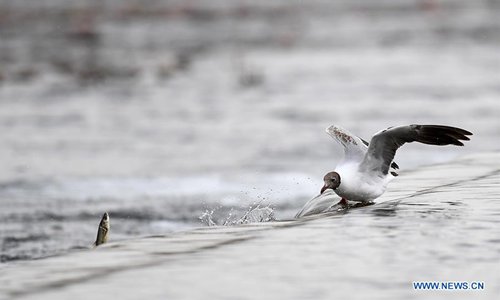
A brown-headed gull waits for catching a naked carp in Shaliu River, Gangca County of northwest China's Qinghai Province, July 6, 2019. The species of carp, known in China as huangyu, is endemic to the Qinghai Lake, China's largest inland saltwater lake located on the plateau. From late May to mid-August every year, the carp swim upstream to freshwater rivers to spawn, with the migration peaking in late June. The fish was listed on the China Species Red List in 2004 due to overfishing and habitat loss. Thanks to the increased efforts of volunteers and intensified law enforcement, the stock of the carp in the lake has largely climbed in recent years.(Photo: Xinhua)